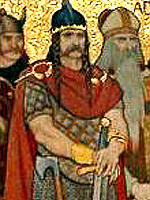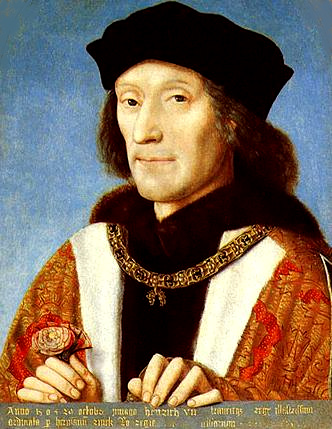In a my posting about why the Duchess of Cambridge is not "Princess Catherine", I stated that Prince Philip’s
surname is Mountbatten, which he adopted from his maternal relatives in the
United Kingdom. This raises the issue of the royal family’s
surname. The royal house is called Windsor but Prince Philip’s surname is Mountbatten. What’s going here? Why isn’t there a surname for William, Kate,
and George on the birth certificate? Has royalty ever used surnames?
Well, to explain this requires some background information on surnames in general. Up until the 12th and 13th centuries, surnames were generally rare and given (first) names were used. But people also became known by their profession (Miller, Smith, etc.), location or place (Stirling, Farmworth, O’Brien, etc.), nickname based on appearance, temperament, and personality (Gutman, Daft, etc.), or in relation to somebody else (McDonald, Fitzgerald, Johnson, etc.). Eventually, these became the surnames used to differentiate people with the same given name from one another, so that John the Miller, Thomas of Stirling, and Henry, John’s son became John Miller, Thomas Stirling, and Henry Johnson.
With regard to the history of the monarchy, royal house names (which may or may not be used as a personal family surname) followed in much the same way, with locations, place names, nicknames, achievements, and relations being used to name royal families. The first royal house in my British monarch’s timeline, the Scottish House of Alpin was named from Kenneth I’s father, Alpin. Kenneth is known today as Kenneth MacAlpin, which means “Kenneth, son of Alpin.”
In England, its first royal family was the House of
Wessex, named from the Kingdom of Wessex, whose kings came to dominate the
other English kingdoms and established a unified English state. Similarly, the
Normans were known from their ancestral land, Normandy. Yet these were not surnames, and individual members of the early royal houses were known by personal epithets, nicknames, and territorial designations (Edmund Ironsides, Edward the Confessor, William the Conqueror, William Rufus, Stephen of Blois, John Lackland, etc). But the members of
the
House of Plantagenet became the first royal family in England to be known by a
surname in their own time. It was a nickname given to Geoffrey, Count of Anjou
– the father of Henry II of England – because his emblem was a planta
genista (or Scotch broom shrub). He is retroactively referred to as Geoffrey Plantagenet, but it was not until the
15th Century when the name was used by Richard Plantagenet, 3rd Duke of York, as a personal surname. During his time, the Plantagenet dynasty
was divided between two rival braches – Richard’s House of York and Henry VI’s House
of Lancaster, but members from both factions continued to use the Plantagenet name as a means of emphasizing their status and claims to the throne.
Meanwhile in Scotland, the Stewart family ascended to the throne in 1371. The Stewart name was derived from the family’s hereditary office of High Steward of Scotland. A steward was a
position like that of a modern-day governor or deputy, who was appointed by
the monarch to represent them in certain situations and act in their stead, if necessary. The
first man to hold the title was Walter Fitz-Alan, whose surname meant “son of
Alan.” He was succeeded by his son, Alan Fitz-Walter (“son of Walter”), who was
in turn succeeded by his own son, Walter, who decided to adopt the name of his
title as his personal surname, which became Steward and eventually, Stewart (Stiùbhairt
in Gaelic). It was Walter Stewart, 6th High Steward of Scotland who married Marjorie Bruce, daughter of Robert I of
Scotland, and had a son through her named Robert. Robert Stewart, Earl of Strathearn – a title now held by Prince William – eventually
became the heir to the Scottish throne after his uncle, David II, and succeeded him
as Robert II, the first monarch of the House of Stewart (which probably became the first royal house in Britain to derive its name from a personal family surname).
Well, to explain this requires some background information on surnames in general. Up until the 12th and 13th centuries, surnames were generally rare and given (first) names were used. But people also became known by their profession (Miller, Smith, etc.), location or place (Stirling, Farmworth, O’Brien, etc.), nickname based on appearance, temperament, and personality (Gutman, Daft, etc.), or in relation to somebody else (McDonald, Fitzgerald, Johnson, etc.). Eventually, these became the surnames used to differentiate people with the same given name from one another, so that John the Miller, Thomas of Stirling, and Henry, John’s son became John Miller, Thomas Stirling, and Henry Johnson.
 |
| Kenneth MacAlpin, the man whose family would usher in a more united Scotland. |
With regard to the history of the monarchy, royal house names (which may or may not be used as a personal family surname) followed in much the same way, with locations, place names, nicknames, achievements, and relations being used to name royal families. The first royal house in my British monarch’s timeline, the Scottish House of Alpin was named from Kenneth I’s father, Alpin. Kenneth is known today as Kenneth MacAlpin, which means “Kenneth, son of Alpin.”
 |
| William II was known
as William Rufus. Rufus means "red", and William had a red-faced appearance. |
 |
|
Richard Plantagenet, the founder
of the House of York. |
Meanwhile in Scotland, the Stewart family ascended to the throne in 1371. The Stewart name was derived from the family’s hereditary office of High Steward of Scotland. A steward was a
 |
| Robert II, seen here with his second wife Euphemia, was the first Stewart monarch of Scotland. |
Back in England, the Wars of the Roses ended with the defeat of the Yorkist king, Richard III by the Lancastrian claimant, Henry
 |
| Henry Tudor, who
became Henry VII of England, founded the House of Tudor. |
 |
| James VI &
I brought the Stuart's to new heights by uniting the crowns of Britain... |
 |
| ...but his son Charles I lost it all (including his head). |
The Stuart family held on to the thrones of Great Britain (England and Scotland merged in 1707) and Ireland until 1714,
 |
| George I, the first British monarch of the House of Hanover, which would reign in Britain for nearly 200 years. |
 |
| Queen Victoria, the last British Hanoverian monarch, whose surname through Prince Albert was likely Wettin. |
In short, personal surnames were used by some, but not all, royal families in Britain, and surnames were inconsistently, if ever, used. Everyone belonged to a royal house, but the name of the royal house was not necessarily the personal family surname (i.e., members of the Houses of York and Lancaster referring to themselves as Plantagenet), if indeed a surname existed at all. Certainly the Hanoverians – who brought in a formal system of titling members of their house as prince or princess by birth from their native Germany – eschewed surnames altogether since it was believed that persons with such a dignity did not need to have one anyway. It was also assumed that royalty married each other, and that once again, surnames were not required as birthright princely titles were handed down from generation to generation. In other words, members of a royal house were to be individually referred to by their titles, and collectively by the name of the royal house to which they belonged. But beginning with George V during the slaughter of the World War I, this would change.
I discuss this change and more in Part II, which concerns the reigning House of Windsor.
Photo Credit: Tastepaper123 Wikimedia Commons cc
No comments:
Post a Comment